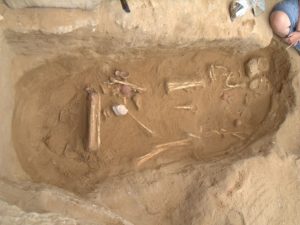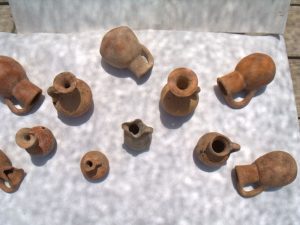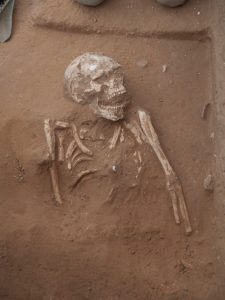Archaeologist of the Leon Levy Expedition discovered what is believed to be a first and only discovered Philistine cemetery. The find was made in Ashkelon, South Israel and is considered to be 3000 years old. The most important aspect of the discovery is that is shows close ties of the buried with the Phoenician world as the manner of burials indicates that the Philistines came from the Aegean Sea region.

The cemetery is located outside the city walls of Tel Ashkelon, which was one of the Philistines’ primary cities (beside Ashdod, Ekron, Gath, and Gaza) in the ancient lands that is now Israel. More than 150 individual burials were discovered, dating from 11th to 8th cent. BC. The burial practice is different than the one present in the region. The deceased were mostly buried in oval pits, 4 of over 150 were cremated and deposited in ashlar burial chamber tombs, what is well known in the Aegean cultural sphere, and absent in the Canaanite one.

Finds that accompanied the deceased included most often storage jars, bowls, juglets, rarely fine jewellery, and arrowheads and spear points. One of the graves contained a hoard of iron arrowheads by the pelvis of the individual. The same grave contained also few pieces of jewellery. Next to other deceased small vials, supposedly for perfume, were placed. In cases of 2 graves the bottle was found at the nostril, presumably so the individual could smell perfume throughout eternity.

Aside of the 150 individual graves, six burial chambers with multiple graves were found, including a rectangular burial chamber with perfectly hewn sandstones. Shards of pottery found inside indicate that it was used in 7th cent. BC, but probably was built earlier.

The discovery allows archaeologists to study Philistine burial practices for the first time but also sheds more light on the characteristics and lifestyle of these people and also dietary habits and morbidity. So far it was recognised that the cultural practises are substantially different from the contemporary Canaanites and the highlanders in the East. The physical anthropologists working at the site, Dr. Sherry Fox, is sampling bones for further analysis, such as DNA studies, radiocarbon dating and biological distance studies. They might indicate where these people came from.

The Philistines were not indigenous to Canaan, what is indicated by ceramics, architecture, pottery remains with writing in non-Semitic language and the newly discovered burial customs. The Bible points to the place called Caphtor, identified with the island of Crete, as the place from which they migrated to the Canaan coast. The Philistine city of Ashkelon, during the Iron Age (ca. 1185-604 BC) was an important gateway between the East and West, through the trade that passed here, including wine, textiles, linen, papyrus and slaves.
(after Haaretz)